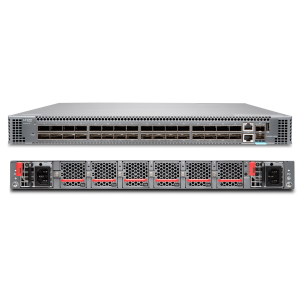
Juniper QFX5120 and QFX5210 switches deliver high-performance, scalable, and resilient networking for enterprises and data centres. Whether deployed at top-of-rack, aggregation, or in spine/leaf fabrics, these switches empower your infrastructure to scale, automate, and adapt to evolving workloads.
As a trusted UK Juniper partner, we leverage decades of IT expertise and our network of Juniper-certified technicians to ensure the success of QFX switch deployments.
Whether your team needs help selecting the right QFX5110 model and licensing, or if they could benefit from our switch pre-configuration service, installation support, or ongoing maintenance, we’re here to make the process seamless.
Book a free 30 minute consultation today to discuss your requirements with our experts.
Expanding your IT network with Juniper switches? Our FAQ answers 6 common questions for large enterprises and data centres.
Q1. Can the Juniper QFX5120 support mixed-speed server connectivity?
Yes. The QFX5120 is designed for environments where servers may use a mix of 10GbE, 25GbE, and 100GbE links. This flexibility allows gradual migrations without forcing a full infrastructure upgrade.
Q2. How well does the QFX5120 scale for routing-heavy environments?
The QFX5120 supports advanced routing protocols such as BGP, OSPF, and IS-IS with capacity for tens of thousands of routes. For larger deployments with higher route density or more BGP sessions, the QFX5210 provides additional headroom and scale.
Q3. Are there deployment considerations when using QFX switches for EVPN-VXLAN fabrics?
Yes. The QFX5120 is often deployed at the leaf for EVPN-VXLAN architectures, while the QFX5210, with its higher throughput and port density, is a stronger fit for the spine. Both platforms integrate seamlessly into modern fabric designs.
Q4. Which switch is more suitable for top-of-rack vs spine/core roles?
| Deployment Factor | QFX5120 | QFX5210 |
|---|---|---|
| Top-of-rack / aggregation | (Possible, but less common) | |
| Spine / core roles | (Limited scale) | (Optimised for scale) |
| Mixed server access (10/25/100GbE) | ||
| Very high throughput fabrics |
Q5. Do these switches support advanced routing in enterprise data centres?
Both switches support enterprise-grade routing with Junos OS, including BGP, OSPF, and IS-IS. The QFX5120 provides sufficient scale for most aggregation and leaf roles, while the QFX5210 is designed to handle larger routing tables and more complex topologies.
Q6. How do they compare in terms of automation and telemetry?
Both the QFX5120 and QFX5210 integrate with automation frameworks via Junos OS APIs (NETCONF, REST, gRPC), offer Zero Touch Provisioning, and support real-time streaming telemetry. The QFX5210 provides enhanced telemetry scale, making it a better fit for large spine or core environments.









